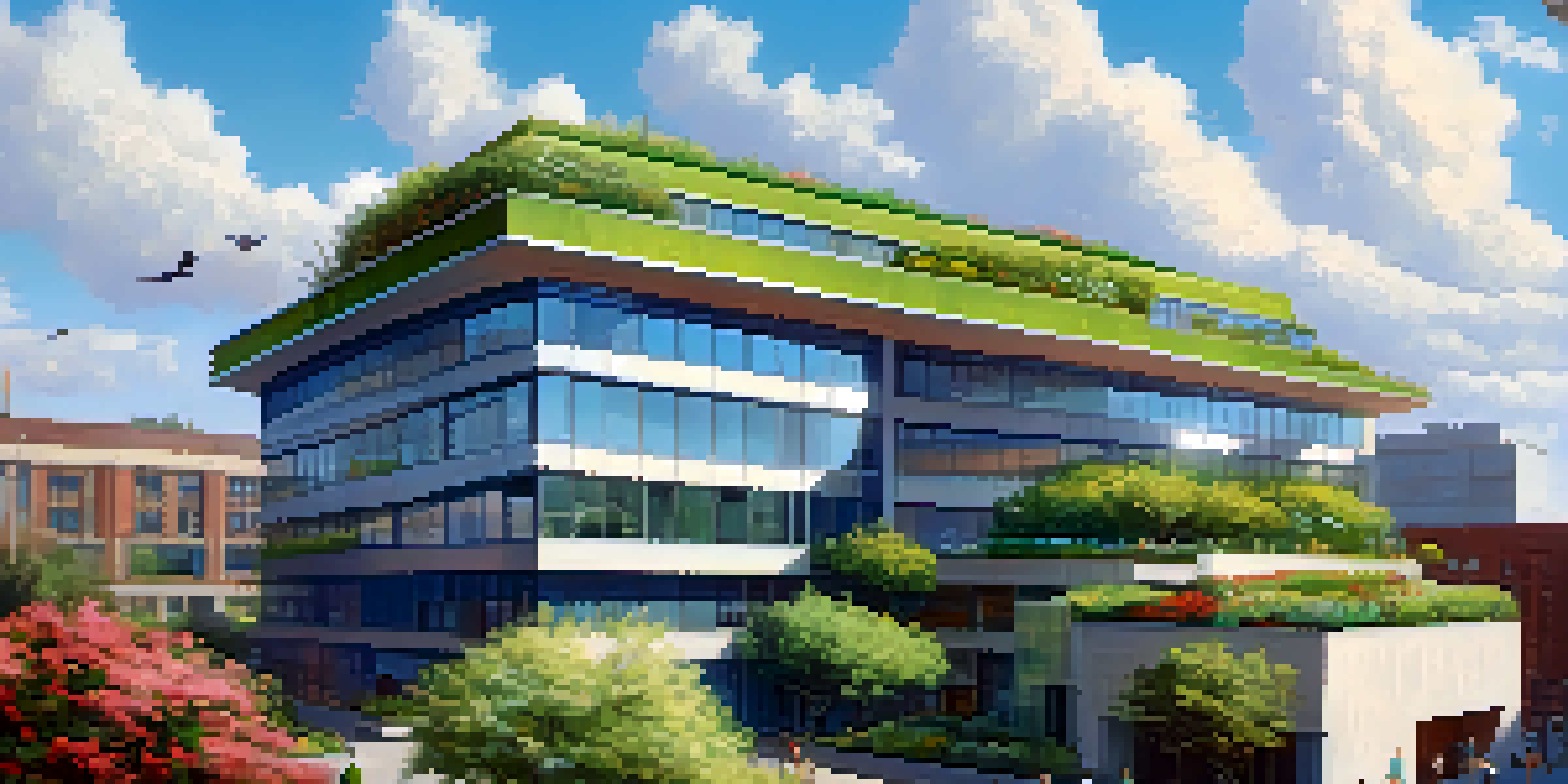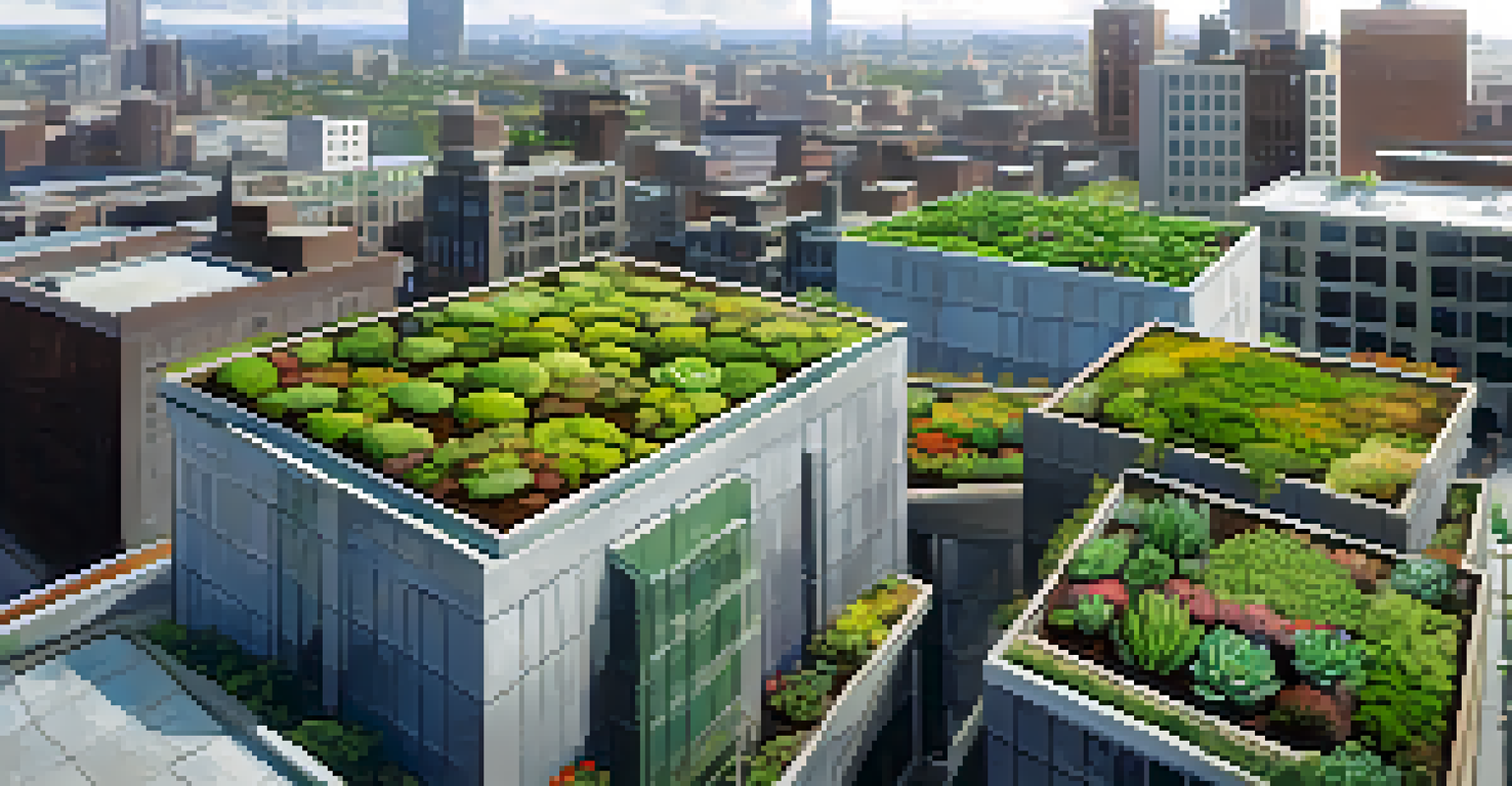The Energy Savings Benefits of Residential Green Roofs

Understanding Green Roofs and Their Components
Green roofs are essentially living roofs covered with vegetation, soil, and a waterproof membrane. They come in two main types: extensive and intensive, depending on the depth of the soil and the types of plants used. While extensive green roofs are lighter and require less maintenance, intensive roofs can support a wider variety of plants and even recreational spaces. Both types offer unique benefits that can lead to significant energy savings.
The green roof is an act of defiance against the urban jungle, a way to reclaim nature in the city.
By insulating the building, green roofs help to regulate indoor temperatures, which is crucial for reducing heating and cooling costs. During summer months, the plants absorb sunlight and provide shade, keeping the building cooler, while in winter, they act as an insulating layer, retaining heat. This natural temperature regulation can lessen the reliance on HVAC systems, ultimately leading to lower energy bills.
In addition to energy efficiency, green roofs contribute to urban biodiversity by providing habitats for birds, insects, and other wildlife. By encouraging a variety of plant species, they enhance the ecological balance in urban settings. This dual benefit of energy savings and ecological support makes green roofs an attractive option for homeowners looking to make a positive impact.
How Green Roofs Reduce Energy Consumption
One of the primary ways green roofs save energy is through the reduction of the urban heat island effect. Urban areas tend to be warmer than their rural counterparts due to concrete, asphalt, and minimal vegetation. By introducing green roofs into the urban landscape, we can significantly lower surface and air temperatures, which in turn reduces the energy required for cooling buildings.

Research indicates that buildings with green roofs can experience a reduction in summertime rooftop temperatures by up to 40 degrees Fahrenheit. This significant temperature drop means that air conditioning units won’t have to work as hard, translating to lower energy use and costs. In fact, a well-designed green roof can lower cooling energy consumption by as much as 30%.
Green Roofs Save Energy Costs
Green roofs help reduce heating and cooling costs by providing natural insulation and regulating indoor temperatures.
Moreover, green roofs can also contribute to heating savings during the colder months. They act as an extra layer of insulation, minimizing heat loss. Homeowners can expect to see a decrease in their heating bills, as the roof helps maintain a stable indoor temperature, making the home more comfortable year-round.
The Role of Vegetation in Energy Efficiency
The type of vegetation chosen for green roofs plays a crucial role in maximizing energy efficiency. Drought-resistant plants, such as sedums and succulents, are commonly used because they require minimal maintenance and can thrive in a variety of conditions. These plants not only provide aesthetic appeal but also contribute to the roof’s overall energy-saving capabilities.
Living roofs can help reduce energy costs, improve air quality, and support biodiversity, all while making our cities more beautiful.
Additionally, the layers of soil and plants work together to absorb rainwater, reducing runoff and promoting better stormwater management. This absorption helps cool the surrounding environment, further aiding in the reduction of energy consumption. A well-planned selection of plants can enhance the roof's ability to mitigate heat, making it a smart investment.
By integrating native plants into the design, homeowners can create a sustainable ecosystem that requires less water and maintenance. This not only saves time and effort but also supports local wildlife, promoting biodiversity. Choosing the right vegetation is key to maximizing the benefits of a green roof.
Financial Incentives and Long-Term Savings
Investing in a green roof may seem daunting at first, but numerous financial incentives are available. Many local governments and utilities offer rebates or tax credits for homeowners who install green roofs, recognizing their energy-saving potential. These incentives can significantly offset installation costs and make green roofs more accessible.
Beyond initial savings, homeowners can expect long-term financial benefits from reduced energy bills. Studies have shown that homes with green roofs can save thousands of dollars over their lifetimes through lower heating and cooling costs. Additionally, green roofs can increase property values, making them a wise investment for the future.
Enhance Urban Biodiversity
By supporting a variety of plant species, green roofs create habitats for wildlife, improving ecological balance in urban areas.
Moreover, as energy prices continue to rise, the savings from green roofs become even more pronounced. Homeowners can enjoy peace of mind knowing that they are making a sound financial decision while reaping the environmental rewards of a sustainable roof.
Enhancing Air Quality with Green Roofs
Green roofs contribute to improved air quality in urban areas, which is another aspect of their energy-saving benefits. Plants naturally absorb carbon dioxide and release oxygen, helping to reduce the amount of greenhouse gases in the atmosphere. This respiratory boost is especially vital in densely populated cities where air quality can be poor.
Furthermore, vegetation can filter pollutants and particulate matter from the air, leading to cleaner, healthier surroundings. By acting as a natural air purifier, green roofs not only benefit the homeowners but also the entire community, promoting a healthier urban environment.
In addition to these benefits, green roofs can also help manage stormwater runoff, which is often contaminated with pollutants. By absorbing rainwater, they reduce the burden on municipal systems and prevent contaminants from entering local waterways. Cleaner air and water mean a healthier ecosystem overall.
Combating Climate Change with Green Roofs
Green roofs play a significant role in combating climate change by reducing energy consumption and lowering greenhouse gas emissions. As cities continue to grow, the need for sustainable solutions becomes more urgent. By implementing green roofs, homeowners can contribute to a larger movement toward environmental sustainability.
These roofs help to mitigate the impacts of climate change by absorbing carbon, reducing energy use, and promoting biodiversity. As more homeowners make the switch to green roofs, the cumulative effect can lead to a substantial decrease in urban emissions. This collective effort is crucial for creating a sustainable future.
Financial Incentives for Homeowners
Homeowners can benefit from tax credits and rebates for installing green roofs, making them a financially sound investment.
In essence, green roofs are more than just a trendy home improvement; they are a powerful tool in the fight against climate change. By choosing to invest in these living roofs, homeowners can take pride in knowing they are doing their part to protect the planet for future generations.
Getting Started with Your Green Roof Project
If you’re considering a green roof for your home, the first step is to consult with a professional who specializes in green roof design and installation. They can help assess your building's structure, recommend appropriate vegetation, and ensure that the installation meets local regulations. Proper planning is essential to the success of your green roof.
It’s also important to consider the long-term maintenance of your green roof. While many green roofs require less upkeep than traditional landscaping, they still need regular care to thrive. Establishing a maintenance plan will ensure that your green roof continues to provide energy savings and ecological benefits for years to come.

Lastly, remember that every green roof is unique. Tailoring your design to fit your specific needs and environment will maximize its benefits. With the right approach, your green roof can become a beautiful and functional addition to your home, enhancing both your living space and the planet.